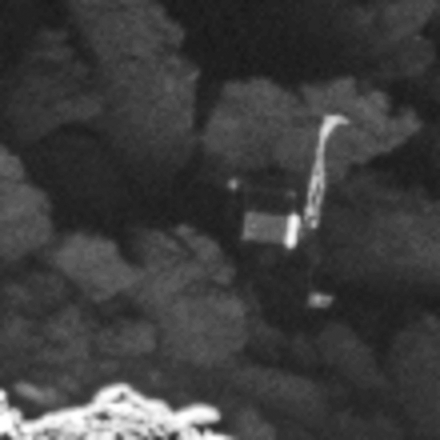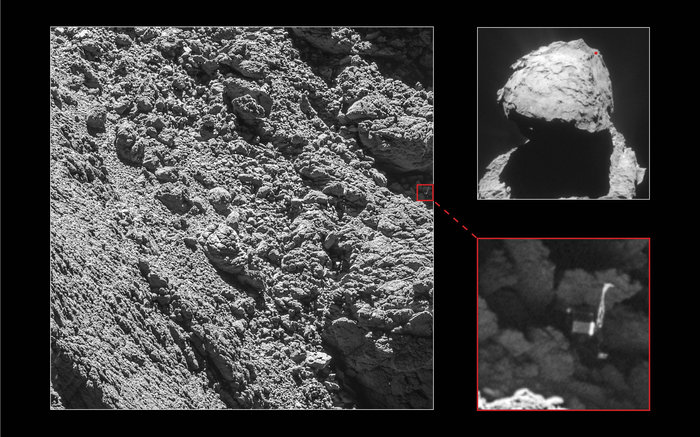The appropriate ending of a “History” that has lasted for over 10 years!
March 2, 2004 , the ESA Rosetta mission, on board Ariane 5 was successfully launched at 7:17 UTC. The pitcher enters the payload and the successive stages eccentric orbit (200 x 4000 km). Two hours later, at 9:14 UTC the next stages provide the energy needed to overcome the force of gravity and to exit Earth’s orbit and to enter heliocentric orbit. The Rosetta probe was released 18 minutes later. The ESA mission control center (ESOC) makes contact with the probe.
12 November 2014 , mission Rosetta of ‘ European space Agency made history thanks to the release on the comet 67P Churyumov Gerasimenko lander Philae . Slightly larger than a washing machine, the lander touched down on 67P making it the first instrument built by man to reach this milestone. It was not a soft landing: Philae touched the ground and then bounced on an area adjacent to that for the anchor, and then encountering some difficulties to be fixed to the ground with his mechanical claw.
27 July 2016 – After months spent playing catch tenaciously one last contact (Philae has remained silent since July 9, 2015), it is time d ‘surrender. At 11.00 in Italy (09:00 UTC) , the communication module Electrical Support System (ESS), the device that enabled the ESA space probe in orbit around the comet 67P / Churyumov-Gerasimenko for contacts on board Rosetta, was off for good.
5 September 2016 – After 14 months of trying and less than a month after the end of the mission, Rosetta “finds” little Philae. The images were taken last Friday, September 2, the narrow-angle camera OSIRIS , while Rosetta was at a distance of 2.7 km from the surface, and show clearly the main body of the lander and two of its three legs.
from the pictures also evident orientation of Philae, and it is now clear why – since the day of ‘landing on the comet, which took place November 12, 2014 – it was so hard to establish communications. The lander is located in the region of Abydos located on the smaller lobe of the comet 67P Chryumov-Gerasimenko

Detail of the lander. Credits: ESA / Rosetta / MPS for OSIRIS Team MPS / UPD / LAM / IAA / SSO / INTA / UPM / DASP / IDA
” It is wonderful news, because “, underlines the project scientist Rosetta Matt Taylor , ESA,” means finally have the information that we lacked to frame in the right context, now that we know what land it was, the data collected from the lander during the three days of scientific operations . “
INTERESTING ARTICLES
the comments of the Rosetta team
“ With only a month left for the Rosetta mission, we are so happy to have finally resumed Philae, and able to see in this amazing level of detail ,” he said Cecilia Tubiana of the OSIRIS camera team, the first to see the images as they were unloaded from Rosetta yesterday.
“ After months of work, with the focus and the evidence pointed more and more about this candidate lander, I am very pleased and excited that we finally have this very important photos of Philae sitting in Abydos “he said Laurence O’Rourke ESA , who coordinated the research at ESA in recent months, with the teams OSIRIS and SONC / CNES.

The discovery of Philae. Credits for the main picture and the detail: ESA / Rosetta / MPS for OSIRIS Team MPS / UPD / LAM / IAA / SSO / INTA / UPM / DASP / IDA. For the image of the lobe of the comet: SA / Rosetta / NavCam
“ A new emotion regalataci from Philae! – does not hide his relief Mario Salatti ASI responsible for the Italian contribution to the mission – after the first landing on a comet, the first in-situ observations, the awakening 7 months after the exhaustion of the primary battery and exciting but unsuccessful attempts to resume operations, here is what the scientists were waiting to know in order to contextualize the data collected during about 52 hours of the first phase scientific . “
Finding the final landing point of Philae had become a race against time, with the end of Rosetta operations planned for the next 30 September. “ E ‘was important – says Salatti – the commitment of the team of the Italo-German Chamber OSIRIS and the ESAC Centre of ESA that have pursued until’ last this goal important . “
The image taken by the OSIRIS camera
the triangulations radio had confined within an area that s’estendeva for a few dozen meters. Now, from a distance of 2.7 km, the resolution of the OSIRIS narrow-angle camera is about 5 cm per pixel, therefore, sufficient to distinguish, among the many “candidates” in that area, the main body of Philae – great about a meter – and his legs, as shown in the accompanying images.
” This is a remarkable discovery, which reaches After a long and meticulous research. By now we were about to give up for lost Philae. It’s amazing to be able to capture these images just at the last moment “, comments the mission manage r Rosetta Patrick Martin , ESA, referring to the fact that in less than a month also will drop the probe on the surface of the comet.
“ Now that the search for the lander is finished, we feel ready for landing Rosetta, and we look forward to capture even more close-up pictures of Rosetta atterragio site “added Holger Sierks , Principal Investigator of the OSIRIS camera.
Rosetta: the end of the mission
September 30 , in fact, Rosetta will undertake his mission final, a one-way trip to study 67P closely, including open pits identified in the Ma’at region, where he hopes to make observations in a position to help us unlock the secrets of the internal structure of the comet.
the European Space Agency (ESA), has announced that more information on the research that led to the discovery of Philae, and additional images, will be available soon.
reference sources: Asi – Esa
No comments:
Post a Comment